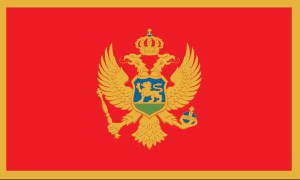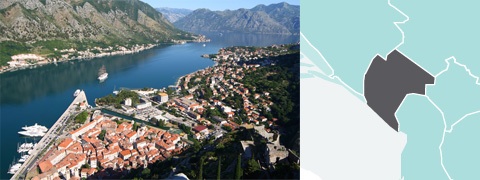Country assessments
Montenegro
- Details
- Country assessments
2013 sector transition indicators
Source: EBRD.
Note: Water – Water and wastewater; IAOFS – Insurance and other financial services; PE – Private equity.
Highlights
- The fiscal position has weakened considerably over the past year. Weak growth and the activation of sizeable state guarantees for the aluminium company, Kombinat Aluminijuma Podgorica (KAP), have taken a significant toll on public finances in 2013.
- European Union (EU) accession negotiations are advancing. Montenegro opened accession negotiations in 2012 and has so far provisionally closed two of the 35 EU acquis chapters over the past year. Under the new enlargement rules Montenegro will have to begin work on the more difficult chapters related to the judiciary and justice early in the accession process.
- Generation capacity in the energy sector is expanding. A number of small hydropower plants are currently under construction, and there has been considerable investor interest in the construction of a second unit in the Plevlja thermal power plant. Plans for commencing the construction of the Italy-Montenegro underwater cable are advancing.
Key priorities for 2014
- The fate of KAP should be resolved as soon as possible. The financial difficulties of the company have spilled over to the public sector. A sustainable solution to the widening fiscal gap will not be possible unless KAP’s liabilities are resolved.
- Efforts should be stepped up to address the high level of non-performing loans (NPLs) in the banking sector. NPLs represent nearly 20 per cent of total loans, and provisions are below 40 per cent. Regulatory barriers to the enforcement, restructuring or write-off of NPLs need to be removed.
- Further reforms are needed in infrastructure, especially in roads and certain municipal and environmental sectors. These sectors could benefit from greater commercialisation, especially through public-private partnership (PPP) projects.
Macroeconomic performance
Economic performance remains weak. A strong tourism season provided Montenegro’s struggling economy with a major boost in 2011, but the contribution of external demand to economic growth decreased significantly in 2012. Domestic demand did not pick up the slack, as consumption and investment remained weak and credit growth continued to decline. As a result, overall GDP contracted by 0.5 per cent in 2012. Economic activity picked up in the first half of this year, especially on the back of recovering exports. The current account deficit – at close to 20 per cent of GDP – remains the highest in the region. Inflation has been moderating throughout 2013, standing at 2.2 per cent year-on-year in August 2013.
The fiscal position has been weakened by the payment of KAP guarantees and weaker than expected growth. On the fiscal side, policies have become more prudent in the past couple of years, but the deteriorating economic situation, and the activation of state loan guarantees related to aluminium producer, KAP, has necessitated revisions of the 2013 budget. However, tax revenues increased by 9 per cent in the first nine months of 2013, aided by several austerity measures, including a rise in income tax rates. The government is considering the introduction of further measures to boost fiscal sustainability.
Negligible growth is expected in the short term. Only a modest recovery from the 2012 recession is expected in 2013. Diversification of the economy remains a challenge for building sustainable growth in the medium term, but the visible progress in the EU approximation process should help to attract further foreign direct investment and ultimately boost the country’s growth prospects.
Major structural reform developments
EU accession negotiations are progressing. Montenegro has been in the process of EU accession negotiations since June 2012. In accordance with the new approach for front-loading the most difficult areas in the accession negotiations, Montenegro is subject to additional scrutiny with regard to the functioning of its judiciary and the rule of law. In its latest progress report on Montenegro, published in October 2013, the European Commission noted that two negotiating chapters had been opened and provisionally closed, and that Montenegro had adopted detailed action plans for the two chapters relating to the judiciary and fundamental rights (chapter 23), and justice, freedom and security (chapter 24).
Privatisation plans include the sale of key transport and tourism assets. In addition to the completion of ongoing tenders, the country’s privatisation council plans to prepare tenders for the privatisation of the rail cargo operator, Montecargo, the national airline, Montenegro Airlines, the Igalo Health Institute, and hotel and tourism operators, Budvanska Rivijera and Ulcinjska Rivijera, among other targets. The council has also stated that it would seek to sign PPP contracts for 32 companies, including the postal operator, Posta Crne Gore, and a number of tourism companies and locations, such as Ada Bojana and Velika Plaza. A number of these state-owned enterprises have been put up for sale over the past few years, but the privatisations failed, mainly due to lack of investor interest.
The government is seeking to restructure KAP. Montenegro’s largest industrial producer and exporter has been in considerable financial distress in recent years, and its problems have major implications for public finances because of substantial state guarantees on its debt. In the first half of 2013 concerns have also arisen about how to ensure a sustainable power supply to the struggling company in light of the growing size of its unpaid electricity bills. The company entered a bankruptcy procedure in July 2013, but it is unclear whether, in the longer term, this will lead to restructuring or closure.
Montenegro performs well on most indicators of the quality of the business environment, but many important challenges persist. Montenegro ranks higher than most regional peers in both the World Bank Doing Business report (forty-fourth of 189 countries) and the World Economic Forum’s Global Competitiveness Index (sixty-seventh of 148 countries). Over the past three years Montenegrin authorities implemented a number of reforms to ease the regulatory burden on businesses, including by reducing taxes and social contributions and simplifying tax procedures, improving the legal framework for bankruptcy procedures, reducing the cost and procedures for obtaining construction permits, and making property registration easier through the introduction of a notary system. Nevertheless, according to the World Bank 2014 Doing Business report, dealing with construction permits, registering property and enforcing contracts remain major challenges for businesses in Montenegro.
Construction of the main road transport corridor is expected to begin at the end of the year. The contract to construct a 44 km section of the 169 km Bar-Boljare motorway was won – through an unsolicited tender – by the China Communications Construction Company (CCCC), whose bid of €810 million was supported by a loan from the Chinese state-owned Export-Import Bank, which will finance 85 per cent of the project. The road will be constructed through challenging terrain, with 24 km of the 44 km length comprising bridges and tunnels. The Bar-Boljare motorway is Montenegro’s largest ever infrastructure project, running between the Adriatic port city of Bar in the south, and the Serbian border in the north.
The energy sector is assuming a more strategic role in Montenegro. The upcoming construction of the underwater cable linking Montenegro’s and Italy’s power networks is attracting further investor interest in this sector. Ten companies submitted bids for the construction of a second 220 MW unit of Montenegro’s only thermal power plant, TE Plevlja. This plant currently supplies about half of Montenegro’s total electricity supply, with the remainder coming from hydropower. Several small hydropower plant projects are currently being implemented.
The financial sector is burdened by low profitability and a high, and rising, level of NPLs. The Montenegrin banking sector has been reporting negative annual return on equity and negative return on assets since 2008. This weak performance reflects more than four years of continuously declining credit growth. The downward trend in lending to the private sector has only recently reversed, while credit growth has picked up quite strongly in 2013, growing at nearly 4 per cent year-on-year in May 2013. At the same time, the high level of NPLs – just under 20 per cent of total loans as at May 2013 – continues to weigh heavily on banks’ balance sheets, and provisioning is also quite low, at below 40 per cent. In February 2013 the Central Bank of Montenegro and the World Bank (FinSAC) organised a brainstorming workshop aimed at defining concrete steps for the restructuring of NPL portfolios. This pilot initiative has also been supported by the EBRD, which has completed a feasibility study to further support the efforts of the Montenegrin authorities and the World Bank.













